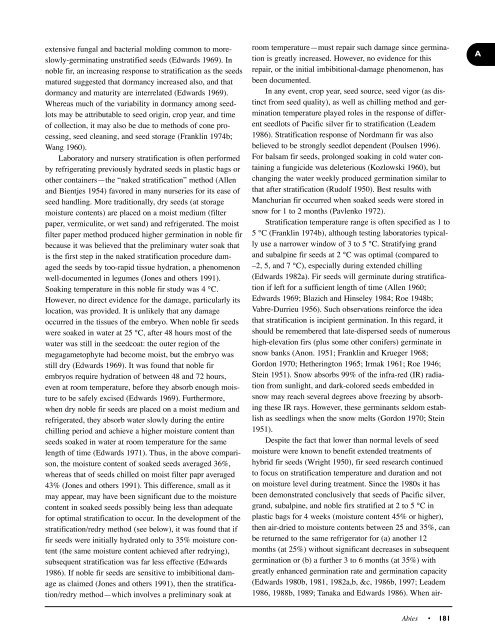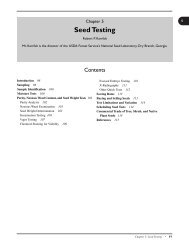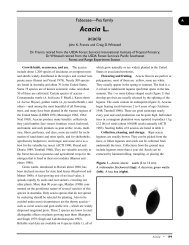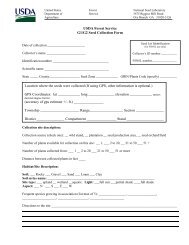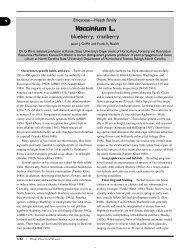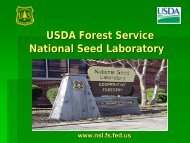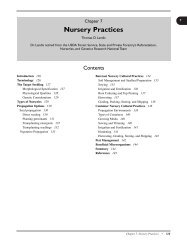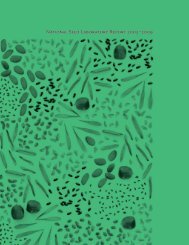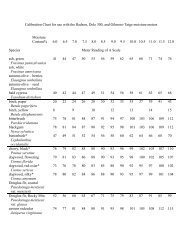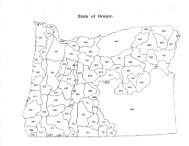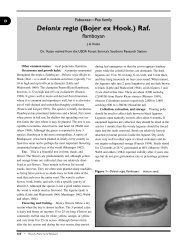extensive fungal and bacterial molding common to moreslowly-germinatingunstratified seeds (Edwards 1969). Innoble fir, an increasing response to stratification as the seedsmatured suggested that dormancy increased also, and thatdormancy and maturity are interrelated (Edwards 1969).Whereas much of the variability in dormancy among seedlotsmay be attributable to seed origin, crop year, and timeof collection, it may also be due to methods of cone processing,seed cleaning, and seed storage (Franklin 1974b;Wang 1960).<strong>Laboratory</strong> and nursery stratification is often performedby refrigerating previously hydrated seeds in plastic bags orother containers—the “naked stratification” method (Allenand Bientjes 1954) favored in many nurseries for its ease ofseed handling. More traditionally, dry seeds (at storagemoisture contents) are placed on a moist medium (filterpaper, vermiculite, or wet sand) and refrigerated. The moistfilter paper method produced higher germination in noble firbecause it was believed that the preliminary water soak thatis the first step in the naked stratification procedure damagedthe seeds by too-rapid tissue hydration, a phenomenonwell-documented in legumes (Jones and others 1991).Soaking temperature in this noble fir study was 4 °C.However, no direct evidence for the damage, particularly itslocation, was provided. It is unlikely that any damageoccurred in the tissues of the embryo. When noble fir seedswere soaked in water at 25 °C, after 48 hours most of thewater was still in the seedcoat: the outer region of themegagametophyte had become moist, but the embryo wasstill dry (Edwards 1969). It was found that noble firembryos require hydration of between 48 and 72 hours,even at room temperature, before they absorb enough moistureto be safely excised (Edwards 1969). Furthermore,when dry noble fir seeds are placed on a moist medium andrefrigerated, they absorb water slowly during the entirechilling period and achieve a higher moisture content thanseeds soaked in water at room temperature for the samelength of time (Edwards 1971). Thus, in the above comparison,the moisture content of soaked seeds averaged 36%,whereas that of seeds chilled on moist filter papr averaged43% (Jones and others 1991). This difference, small as itmay appear, may have been significant due to the moisturecontent in soaked seeds possibly being less than adequatefor optimal stratification to occur. In the development of thestratification/redry method (see below), it was found that iffir seeds were initially hydrated only to 35% moisture content(the same moisture content achieved after redrying),subsequent stratification was far less effective (Edwards1986). If noble fir seeds are sensitive to imbibitional damageas claimed (Jones and others 1991), then the stratification/redrymethod—which involves a preliminary soak atroom temperature—must repair such damage since germinationis greatly increased. However, no evidence for thisrepair, or the initial imbibitional-damage phenomenon, hasbeen documented.In any event, crop year, seed source, seed vigor (as distinctfrom seed quality), as well as chilling method and germinationtemperature played roles in the response of differentseedlots of Pacific silver fir to stratification (Leadem1986). Stratification response of Nordmann fir was alsobelieved to be strongly seedlot dependent (Poulsen 1996).For balsam fir seeds, prolonged soaking in cold water containinga fungicide was deleterious (Kozlowski 1960), butchanging the water weekly produced germination similar tothat after stratification (Rudolf 1950). Best results withManchurian fir occurred when soaked seeds were stored insnow for 1 to 2 months (Pavlenko 1972).Stratification temperature range is often specified as 1 to5 °C (Franklin 1974b), although testing laboratories typicallyuse a narrower window of 3 to 5 °C. Stratifying grandand subalpine fir seeds at 2 °C was optimal (compared to–2, 5, and 7 °C), especially during extended chilling(Edwards 1982a). Fir seeds will germinate during stratificationif left for a sufficient length of time (Allen 1960;Edwards 1969; Blazich and Hinseley 1984; Roe 1948b;Vabre-Durrieu 1956). Such observations reinforce the ideathat stratification is incipient germination. In this regard, itshould be remembered that late-dispersed seeds of numeroushigh-elevation firs (plus some other conifers) germinate insnow banks (Anon. 1951; Franklin and Krueger 1968;Gordon 1970; Hetherington 1965; Irmak 1961; Roe 1946;Stein 1951). Snow absorbs 99% of the infra-red (IR) radiationfrom sunlight, and dark-colored seeds embedded insnow may reach several degrees above freezing by absorbingthese IR rays. However, these germinants seldom establishas seedlings when the snow melts (Gordon 1970; Stein1951).Despite the fact that lower than normal levels of seedmoisture were known to benefit extended treatments ofhybrid fir seeds (Wright 1950), fir seed research continuedto focus on stratification temperature and duration and noton moisture level during treatment. Since the 1980s it hasbeen demonstrated conclusively that seeds of Pacific silver,grand, subalpine, and noble firs stratified at 2 to 5 °C inplastic bags for 4 weeks (moisture content 45% or higher),then air-dried to moisture contents between 25 and 35%, canbe returned to the same refrigerator for (a) another 12months (at 25%) without significant decreases in subsequentgermination or (b) a further 3 to 6 months (at 35%) withgreatly enhanced germination rate and germination capacity(Edwards 1980b, 1981, 1982a,b, &c, 1986b, 1997; Leadem1986, 1988b, 1989; Tanaka and Edwards 1986). When air-A<strong>Abies</strong> • 181
Adried to 35% and refrigerated for a further 3 months, allviable grand fir seeds germinated within 2 weeks (Edwards1980b). This is the result of achieving a synchronicity ingermination achieved by the reduced moisture content thatplaces the embryos under a moisture stress. This stress preventsless-dormant seeds in the mixture from germinating,while allowing more-dormant seeds to achieve a ready-togerminatestate when the extended chilling ends.Subsequently, sowing the seeds on a non-moisture-limitingmedium permits all the viable seeds to germinate at thesame time (Edwards 1981, 1982b, 1986b). In addition, thereduced moisture content “protects” the energy supplies ofthe megagametophyte from being respired as rapidly as inseeds undergoing traditional stratification at high moisturecontent (Leadem 1993).This process, which has become known as the stratification-redrymethod, differs from traditional stratification asshown diagrammatically in figure 18. During routine stratification(upper), seeds are soaked for 24 to 48 hours at roomtemperature, drained, chilled at 2 °C for 4 to 8 weeks intheir “fully imbibed” state (moisture content around 45% orhigher) until they are sown in the nursery. In the newprocess (lower), seeds are soaked for 24 to 48 hours at roomtemperature, drained, and chilled for 4 weeks while fullyimbibed(as in the old method). Then, the stratified seeds areremoved from the refrigerator and air-dried to 30 to 35%moisture content. Next, they were returned to the refrigeratorfor an additional 1 to 3 months of chilling for the mostrapid and complete germination. Alternatively, when dried to25% moisture content and returned to the refrigerator, theycan be kept for up to an additional 12 months until they aresown. The procedure has been described in detail (Edwards1982b, c, 1986, 1997) and is now used operationally inBritish Columbia (Leadem and others 1990). An almostidentical procedure has been described for Nordmann firseeds (Jensen 1997; Poulsen 1996), and control of moisturelevel during stratification has been recommended forGuatemalan fir (Donahue and others 1985).As described above, seeds air-dried to 25% moisturecontent can be “stored” in the refrigerator for up to a yearwithout losing the beneficial effect of the initial stratification,that is, they remain in a ready-to-germinate state.Stratified seeds of noble and Pacific silver firs have beendried to 5 to 9% moisture content and stored for 1 year, afterwhich they germinated significantly better than the originalcontrols (Hall and Olson 1986). For the seedling grower,these methods allow stratification to begin well in advanceof nursery sowing date and/or make the sowing date moreflexible (Edwards 1980b, 1981, 1982a, 1986b). Two additionalbeneficial effects of redrying (to either 35 or 25%)observed in the laboratory were that fungal and bacterialmolding of seeds was greatly reduced and that emergingradicles were more positively geotropic than in germinantsfrom routinely stratified seeds. This latter is important inthat germination in firs is epigeal (figure 19) and a vigoroushealthy radicle is essential for successful seedling establishment.There is little reported evidence of the use of gibberellinsincreasing fir seed germination, but a combinationof stratification for 40 to 60 days and treatment with 200ppm GA 3 worked well for Guatemalan fir seeds (Salazar1991). Use of gibberellin GA 4+7 improved dark-germinationof Fraser fir at 30/20 °C over a 42-day test but was ineffective(light or dark) at 20/15 °C unless the seeds were firsthydrated for 20 hours (Henry and Blazich 1988). The beneficialeffect of an auxin has been reported in Sakhalin fir(Yoshida 1960).Germination tests. Stratification treatments for 10 firspecies regarded as consistently dormant are prescribed inseed testing rules (AOSA 1998; Edwards 1987; ISTA 1993),whereas double (paired) tests (with and without stratification)are recommended for 8 other species in which dormancyvaries among seedlots. West Himalayan fir might beadded to the list of species requiring double tests (Khattakand Ahmad 1980), but Korean fir is consistently dormant(Jakimova 1965). The officially prescribed stratificationperiod for all fir species is either 21 or 28 days, the longerperiod being favored by the AOSA rules for 6 species.Alternating temperatures of 30 °C with light for 8 hoursand 20 °C for 16 hours without light are standard for mostfir species, with 3 notable exceptions. For Pacific silver fir,the current AOSA prescription is for 25 °C (light) for8 hours and 15 °C (dark) for 16 hours. However, seeds ofthis species germinate more slowly but more completely at15 °C (light) for 8 hours and 10 °C (dark) for 16 hours(Leadem 1986). Similarly, subalpine fir seeds stratified for8 weeks germinate well under a 25/15 °C regime (Hansenand Leivsson 1990; Leadem 1989), whereas Fraser fir seedsstratified for 12 weeks germinate well at 20 °C for 8 hourswith light for 1 hour (only) during the latter part of thiswarm period, followed by 10 °C (dark). If stratified for8 weeks only, Fraser fir seeds should be tested at the standard8/16 hours 30/20 °C, with a 1-hour light treatment duringthe higher temperature (Adkins 1984; Adkins and others1984; Henry and Blazich 1990). The involvement of phytochromehas been demonstrated in the germination responsesof Fraser fir (Henry and Blazich 1990) and is suspected inseveral other firs (Li and others 1994; Nagao and Asakawa1963; Messeri and Salvi 1964), making it essential to usefluorescent-only lighting for laboratory tests (Asakawa1959; Blazich and Hinseley 1984; Nagao and Asakawa1963).182 • Woody Plant <strong>Seed</strong> Manual
- Page 6 and 7: seeds or grafts have been establish
- Page 8 and 9: finely ground needles on open cuts;
- Page 10: hybrids between grand and white fir
- Page 13 and 14: AGuatemala have been reported (Agui
- Page 17 and 18: AFigure 5—Abies, fir: mature seed
- Page 19: Aber on the south side of the tree
- Page 22 and 23: developing male strobili (Bess 1946
- Page 24 and 25: Table 6—Abies, fir:cone and seed
- Page 26 and 27: Figure 13—Abies procera, noble fi
- Page 28 and 29: Table 7—Abies, fir:cone drying sc
- Page 30 and 31: Table 8—Abies, fir: cone measurem
- Page 32 and 33: Table 10—Abies, fir: nursery prac
- Page 36 and 37: Figure 18—Abies, fir: schematic c
- Page 38 and 39: Fir seedling production in Canadian
- Page 40 and 41: ReferencesAAbbott HG. 1962. Tree se
- Page 42 and 43: Ebell LF, Schmidt RL. 1964. Meteoro
- Page 44 and 45: Hamrick JL, Libby WJ. 1972. Variati
- Page 46 and 47: Kulhavy DL, Schenk JA. 1976. Cone a
- Page 48 and 49: Owens JN, Molder M. 1977b. Sexual r
- Page 50 and 51: Sjoberg NE. 1974. The Styroblock co


